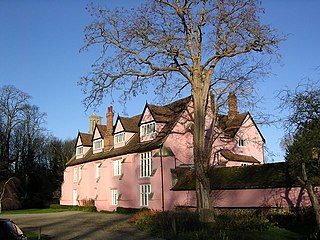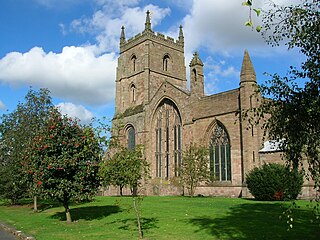Related Research Articles
Luffield Abbey is a place in the very north of Buckinghamshire, England. It is on the border with Northamptonshire, close to Biddlesden and Silverstone.

Swavesey is a village lying on the Prime Meridian in Cambridgeshire, England, with a population of 2,463. The village is situated 9 miles to the north west of Cambridge and 3 miles south east of St Ives.
Sopwell Priory was built c. 1140 in Hertfordshire, England by the Benedictine abbot of St Albans Abbey, Geoffrey de Gorham. It was founded as the Priory of St Mary of Sopwell and was a cell of St Albans Abbey.

Clare Priory is a religious house in England, originally established in 1248 as the first house of the Augustinian Friars in England. It is situated on the banks of the River Stour, a short distance away from the medieval village of Clare, Suffolk. The friary was suppressed in 1538 and the property passed through many hands until it was again purchased by the Augustinian friars in 1953. Today the Priory offers modern retreat facilities for guests.

Isleham Priory Church, located in Isleham, Cambridgeshire, is a Norman church, built in ca 1090. Despite being converted into a barn, it remains in a largely unaltered state.

The Priory Church is an Anglican parish church in Leominster, Herefordshire, England, dedicated to Saint Peter and Saint Paul. The building was constructed for a Benedictine Priory in about the 13th century, although there had been an Anglo-Saxon monastery in Leominster, possibly on the same site. In 1539 the east end of the church was destroyed along with most of the monastic buildings, but the main body of the church was preserved.

Snelshall Priory was a Benedictine priory in Milton Keynes, Buckinghamshire in the United Kingdom, built around 1200. The priory was founded after Sybil d'Aungerville granted land at Tattenhoe to Lavendon Abbey, a Premonstratensian monastery of 'White canons' who most likely started a cell at Snelshall. This did not thrive and was abandoned about 1207. About 1219, the founder's son brought in Benedictine monks, increased the endowment and the new monastery began again. However Snelshall Priory paid 1 mark a year to Lavendon until 1232, at which point the Bishop of Lincoln decided that Snelshall owned its own lands and chapel. The priory accumulated various land through gifts, but even with all these grants, in 1321 when Henry Burghersh visited, it was so poor that "the monks scarcely had the necessities of life and had to beg even for these".

The remains of St Mary's Abbey, of Kenilworth, Warwickshire, England are situated in the grounds of St Nicholas' Church and in an adjacent area of Abbey Fields. Some of its ruins are above ground and some are below ground.

Swavesey railway station was a station in Swavesey, Cambridgeshire on the line between Cambridge and St Ives which was closed for passenger services in 1970. The station remained derelict until it was demolished in 2007 for construction of the Cambridgeshire Guided Busway service which utilises the trackbed of the old railway.

St Ives Priory was a priory in Cambridgeshire, England. It was established in 1017 by monks from Ramsey Abbey.
Horton Priory was a priory at Horton in Dorset, England.
Boston Priory was a priory in Boston, Lincolnshire, England.
Cammeringham Priory was a priory in Cammeringham, Lincolnshire, England.

Deeping St James Priory was a priory in Deeping St James, Lincolnshire, England. In 1139 Baldwin Fitz Gilbert established the Benedictine Priory of Saint James at Deeping as a cell of Thorney Abbey. The cell was dissolved at the surrender of Thorney in 1539. The priory church remains as the Church of England parish church of Deeping St James and is a Grade I listed building.
Freiston Priory was a Benedictine cell of Crowland Abbey founded in 1114, and became a priory soon afterwards. It was Dissolved in 1539 and was located in Freiston, Lincolnshire, England.

Pentney Priory was an Augustinian priory at Pentney in the district of King's Lynn and West Norfolk, Norfolk, England. The ruins of the priory, mostly comprising the flint-built gatehouse, are Grade I listed.
Eye Priory was a Benedictine Priory dedicated to St Peter in the town of Eye in the English county of Suffolk. It was founded by Robert Malet c. 1080 and originally an Alien Priory dependent on Bernay Abbey in Normandy. It became independent in 1385 by charter of Richard II when it could support only 3-4 monks. It was finally dissolved in 1537 as part of the Dissolution of the Monasteries, with the lands being given to Charles Brandon, 1st Duke of Suffolk.

Rumburgh Priory was a Benedictine priory located in the village of Rumburgh in the English county of Suffolk. The priory was founded in about 1065 as a cell of St Benet's Abbey at Hulme in Norfolk. At the time of the Domesday Book in 1086 it had 12 monks. The ownership of the priory was transferred to St Mary's Abbey in York towards the end of the 12th century. The monks of Rumburgh were particularly devoted to St. Bee, whom they commemorated at Michaelmas.
Snape Priory was a priory in Suffolk, England. It was founded as a cell of the Benedictine St John's Abbey, Colchester in Essex.
References
- ↑ A History of the County of Cambridge and the Isle of Ely: Volume 9: Chesterton, Northstowe, and Papworth Hundreds. 1989. pp. 374–381.
- ↑ Historic England. "Priory earthworks (1006914)". National Heritage List for England . Retrieved 3 January 2014.
Coordinates: 52°18′20″N0°00′10″E / 52.305653°N 0.002842°E